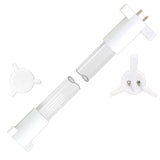What Are Amalgam Fluorescent and Ultraviolet Bulbs?
Posted by Dave on for ProLampSales
The performance of fluorescent tubes, compact fluorescent light bulbs, and low pressure mercury ultraviolet bulbs deteriorates in ambient temperatures that rise above certain design parameters. At high fixture and room temperatures, light output and color characteristics deteriorate.
CFLs are particularly affected by this, as anyone who has had a CFL bulb in a porch light or the garage fail on a hot summer day has learned. But this effect on ultraviolet germicidal bulbs can be even worse, diminishing the lamp's effectiveness in killing bacteria and viruses.
The reason has to do with mercury vapor pressure within the lamp, which depends on temperature.
Some fluorescent bulbs, most commonly compact versions, use a mercury amalgam to extend the optimal bulb operating temperature to higher values. Mercury amalgams are alloys of mercury and other metals. The amalgam stabilizes the mercury vapor pressure when bulb temperatures rise.
Amalgam fluorescent lamps achieve over 90% of light output over a wider temperature range than standard fluorescent. However, these lamps also take longer to reach full light output on start-up than standard fluorescent.
For household and commercial architectural lighting, this extra delay in a fluorescent bulb reaching full light output may be a dealbreaker. Especially in areas like closets where the light may only be on a short while, a slow warm-up time may be unacceptable.
Fluorescent lamps using this technology can usually be identified by their part numbers, which will contain HO or VHO, indicating high output or very high output. These lamps operate at 800mA or 1,500mA, compared to standard fluorescents at 430mA.
Amalgam is important for applications such as recessed downlights where heat can easily accumulate, particularly if the lights are on for a long period of time and the ambient room temperature is relatively high. They are also important in applications where more light is required from one bulb, where adding bulbs of a longer length or increasing the number of bulbs is impractical.
Amalgam is also used in higher output ultraviolet bulbs, where manufacturers can get more UV output from the lamp compared to a standard lamp of the same length. This can be helpful in quickly curing inks as they are printed on specialty materials.
Germicidal bulbs also come in UV amalgam versions and are some of the highest output bulbs available. They require ballasts that can drive these lamps at the proper current. HO and VHO ballasts are more uncommon than regular fluorescent or ultraviolet ballasts, and are usually noticeably more expensive.
Amalgam technology is useful in extending the life of existing fluorescent and CFL bulbs, and can be critical in industrial and commercial applications where higher output from lamps is required. For the same length of bulb, they can have nearly double or triple the output of light or ultraviolet radiation, which may more than justify the increased price of the bulbs and fluorescent ballasts required to drive them.
- Posted in Fluorescent, Ultraviolet Light
Featured Products (View All)
0 Comments




